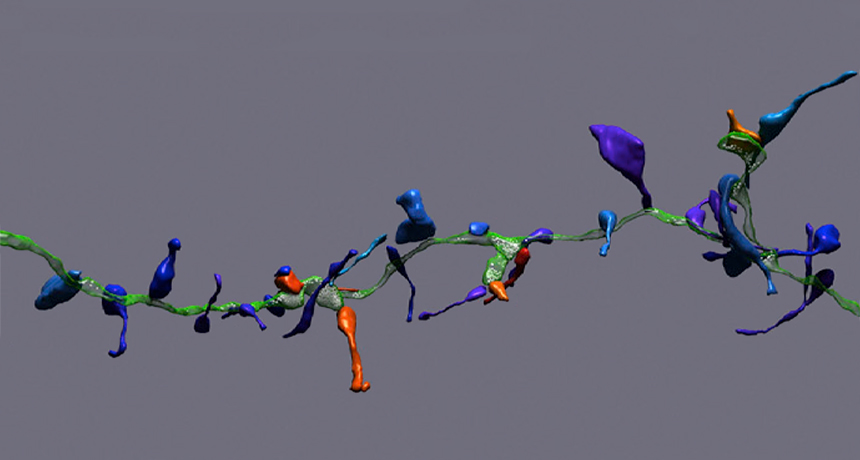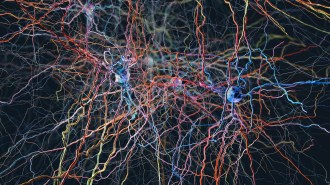New view of mouse brain provides up-close look at nerve cells’ habitat
Detailed imaging shows that being near doesn’t mean making a connection

CONNECT THE NEURONS In this computer rendering of a bit of mouse brain based on scanning electron images, some nerve cell dendrites touch an axon (green) and make connections (orange), while other dendrites don’t (blue).
N. Kasthuri et al/Cell 2015
- More than 2 years ago
A tiny speck of mouse brain hosts a microscopic wonderland, a new study reveals. By characterizing the dense, complex habitat of brain cells down to nanometers, scientists have uncovered clues about how the brain wires itself. Among the early revelations: Nearby brain cells don’t always form connections.
The dataset, published in the July 30 Cell, “sets an example of the kind of experiments that are needed to understand the brain,” says Henry Markram, codirector of the European Commission’s Human Brain Project and a neuroscientist at the Swiss Federal Institute of Technology in Lausanne.
Scientists began with a bit of mouse brain smaller than a poppy seed. An automated process sliced that tiny speck into thin wisps that floated across liquid before being mounted on tape. Once secured, these wisps were photographed with an electron microscope powerful enough to reveal the details of single nerve cells, or neurons. Designing this automated technology, and methods to analyze and visualize the data, took years, says study coauthor Narayanan “Bobby” Kasthuri, now at Argonne National Laboratory and the University of Chicago.
Those efforts paid off. The experiment provides a deep view of the mysterious ways in which brain cells mix and mingle, says Linnaea Ostroff of the Allen Institute for Brain Science in Seattle. “And there are a lot of unanswered questions there,” she says. “There are a lot of relationships between cells that we don’t know about.”
One idea about cellular relations comes from Peters’ rule, which says that when message-sending axons and message-receiving dendrites come into close contact, they always connect with a synapse. But the new dataset, which includes the precise locations of 1,700 synapses, reveals that proximity isn’t enough. By finding axons and dendrites that are very close but not connected with synapses, the results show that Peters’ rule is much too simple. “From our data, it just turns out to be not true,” Kasthuri says. “The more we looked, we couldn’t find any indication that neurons that spent more time with each other in space are more likely to connect with each other.” Scientists have suspected for a while that being close probably isn’t enough to predict connectivity between neurons, Kasthuri says. “Now we have good, strong evidence for it.”
That result doesn’t mean proximity isn’t important, though, says Markram, who points out that neurons can’t connect without being close to each other.
Knowing exactly how the billion neurons in the human brain connect would be an enormously powerful tool for understanding how the brain works in healthy people, and what goes wrong in brain disorders. While not impossible, it’s not feasible to do the same process for large swaths of human brain, says study coauthor Jeff Lichtman of Harvard University. “It would probably require a project on the scale of landing people on Mars.”
Such a detailed map of every part of the brain isn’t necessary if scientists can figure out general rules that govern how brains connect. This new intricate view of a mouse brain, the details of which are available as a dataset for other scientists to explore, offers clues that could ultimately help predict what happens in the brains of people.
These sorts of meticulous projects are worth doing “as long as the data shows things that are not expected,” Lichtman says. “When we understand the brain to the point where what we see is boring — that is the time to stop. We are far from that point now.”
NEURAL HOOKUPS A digital reconstruction reveals the complex connections between nerve cells in a mouse brain. Zooming in throws the neural neighborhood into even greater relief.N. Kasthuri et al/Cell 2015 |






